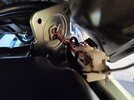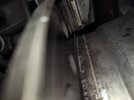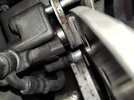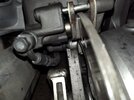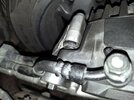The plastic ring is present. It most likely got sucked in because of the new SMC I installed, then used the brakes multiple times, sucking what was left of the reservoir into the system, hence sucking the diaphragm into an upside down top hat shape to fit the reservoir chamber. And if course, even though I read the instructions a few times and I clearly read and remember the front saying to remove the cover AND diaphragm,, I missed the part for the back saying to also remove the diaphragm. Just a bonehead moment...@The Dark Shadow , keep in mind that there should be a plastic disc inserted between that rubber diaphragm / membrane and the cap that is supposed to stop it from being sucked in when the cap is on. Not sure how yours fell in... you may not have had the cap on but just be aware that there is two parts to that rubber seal
You are using an out of date browser. It may not display this or other websites correctly.
You should upgrade or use an alternative browser.
You should upgrade or use an alternative browser.
Gonna try to install one of my 2x new SMC units...
- Thread starter The Dark Shadow
- Start date
Sadlsor
Site Supporter
- Joined
- Jan 15, 2020
- Messages
- 4,461
- Age
- 67
- Location
- Birmingham, Alabama
- Bike
- 2008 ST1300A
- STOC #
- 9065
Nah.Just a bonehead moment...
We call that a TEACHABLE moment.
A lot like riding -- attitude is everything.
I'm somewhat confused by your last comment. When we spoke, I explained that before you attempted to flush/bleed the brake system, that ALL the calipers/pistons/seals/guide rods, should be completely cleaned, inspected, and properly lubricated. You told me that you had done this, and it was completed. Now your comment mentions dirt and rust on the rear pistons???
You can't properly/correctly get your brake system working correctly unless all the parts are working together.
You now state that you think something is warped on the back wheel? I seriously doubt that is the case. What is more than likely happening is the pistons that are dirty/rusty etc, are not moving smoothly and working together making you think something is warped.
Think of it this way, what you did was like trying to level frets on your guitar before you even tweaked or adjusted the truss rod.
Things must be done in the correct order.
The reason your probably feeling the connection between the two levers when you use them, are more than likely still air in the system, and/or sticking pistons/guide rods etc.
I would suggest you do what we talked about at length, clean and inspect everything before you go further, or you're just going to be chasing your tail, and getting more frustrated again.
You can't properly/correctly get your brake system working correctly unless all the parts are working together.
You now state that you think something is warped on the back wheel? I seriously doubt that is the case. What is more than likely happening is the pistons that are dirty/rusty etc, are not moving smoothly and working together making you think something is warped.
Think of it this way, what you did was like trying to level frets on your guitar before you even tweaked or adjusted the truss rod.
Things must be done in the correct order.
The reason your probably feeling the connection between the two levers when you use them, are more than likely still air in the system, and/or sticking pistons/guide rods etc.
I would suggest you do what we talked about at length, clean and inspect everything before you go further, or you're just going to be chasing your tail, and getting more frustrated again.
ToddC
Site Supporter
Easy Larry....... Some don't get the fine details....I'm somewhat confused by your last comment. When we spoke, I explained that before you attempted to flush/bleed the brake system, that ALL the calipers/pistons/seals/guide rods, should be completely cleaned, inspected, and properly lubricated. You told me that you had done this, and it was completed. Now your comment mentions dirt and rust on the rear pistons???
You can't properly/correctly get your brake system working correctly unless all the parts are working together.
You now state that you think something is warped on the back wheel? I seriously doubt that is the case. What is more than likely happening is the pistons that are dirty/rusty etc, are not moving smoothly and working together making you think something is warped.
Think of it this way, what you did was like trying to level frets on your guitar before you even tweaked or adjusted the truss rod.
Things must be done in the correct order.
The reason your probably feeling the connection between the two levers when you use them, are more than likely still air in the system, and/or sticking pistons/guide rods etc.
I would suggest you do what we talked about at length, clean and inspect everything before you go further, or you're just going to be chasing your tail, and getting more frustrated again.
I had cleaned the front.I'm somewhat confused by your last comment. When we spoke, I explained that before you attempted to flush/bleed the brake system, that ALL the calipers/pistons/seals/guide rods, should be completely cleaned, inspected, and properly lubricated. You told me that you had done this, and it was completed. Now your comment mentions dirt and rust on the rear pistons???
You can't properly/correctly get your brake system working correctly unless all the parts are working together.
You now state that you think something is warped on the back wheel? I seriously doubt that is the case. What is more than likely happening is the pistons that are dirty/rusty etc, are not moving smoothly and working together making you think something is warped.
Think of it this way, what you did was like trying to level frets on your guitar before you even tweaked or adjusted the truss rod.
Things must be done in the correct order.
The reason your probably feeling the connection between the two levers when you use them, are more than likely still air in the system, and/or sticking pistons/guide rods etc.
I would suggest you do what we talked about at length, clean and inspect everything before you go further, or you're just going to be chasing your tail, and getting more frustrated again.
The back is now cleaned also.
The back rotor has a slight warp, but seemingly within spec as per the manual.
The back pistons/pads do not recede well and still warm up (not hot, but warm) the back rotor.
I went for a test ride. On my way out, the back rotor got warm. Then I wiggled the back rotor with my two hands, forcing the pistons wider leaving more clearance. Rotor did not get as warm and has mileage slightly improved.
The rear brake pads were replaced late last August or in September.
It seems to me (but you know I'm a dummy with this... or at least a newbie) that the rear caliper pistons do not recede fully. I wonder if there is an adjustment for the recession pressure in the rear master cylinder, where it can have more sucking pressure to suck the pistons in further...??
See my comment above. I said I cleaned the front but still hadn't cleaned the rear.Easy Larry....... Some don't get the fine details....
ToddC
Site Supporter
Not a comment on you.....just poking Larry...... ;-)See my comment above. I said I cleaned the front but still hadn't cleaned the rear.
What you’re describing is not a warped rotor, but a misaligned rear caliper, probably due to a few different things.I had cleaned the front.
The back is now cleaned also.
The back rotor has a slight warp, but seemingly within spec as per the manual.
The back pistons/pads do not recede well and still warm up (not hot, but warm) the back rotor.
I went for a test ride. On my way out, the back rotor got warm. Then I wiggled the back rotor with my two hands, forcing the pistons wider leaving more clearance. Rotor did not get as warm and has mileage slightly improved.
The rear brake pads were replaced late last August or in September.
It seems to me (but you know I'm a dummy with this... or at least a newbie) that the rear caliper pistons do not recede fully. I wonder if there is an adjustment for the recession pressure in the rear master cylinder, where it can have more sucking pressure to suck the pistons in further...??
You said you cleaned the rear caliper/pistons?
Did you remove the caliper off the rotor, remove the spring clip and clean underneath it?
Did you move/remove the pistons to clean the area where they go through the seals? If you did not do this, this may be the reason the pistons are not moving as they should.
Was the rear caliper replaced correctly?
Was the guide dowel(s) cleaned and very lightly greased with rubber friendly grease?
Is the small white O-ring on the pad retaining pin?
Is the rear grommet torn, displaced, or jammed up?
Take a picture of the RIGHT REAR pads as they sit in the front retaining clip.
Your rear caliper mounting bracket may be damaged, as they are often found when the SMC goes out, it takes this bracket with it.
It just would not be a proper smc thread, if we didn't throw up this old photo !!! btw,,, I cooked my rear rotor when my smc failed,,,, and it was fine for a couple of years. I eventually replaced it with a good as new recycled rotor from a ctx that was being parted out,,, as it was below min. thickness by then. Glad to hear that you have this bleed problem sorted out !!,,, CAt'The back rotor has a slight warp, but seemingly within spec as per the manual.
Attachments
I wonder if Amazon sells those brightly colored rotors?It just would not be a proper smc thread, if we didn't throw up this old photo !!!



I think I might have said this earlier, I certainly said it in another recent thread. The pistons are pulled back into the caliper by distortion of the square (cross section) o-ring that is in the groove inside the caliper. To the best of my knowledge, there is no 'suck' or vacuum in the system that pulls the pistons back from the rotors.I wonder if there is an adjustment for the recession pressure in the rear master cylinder, where it can have more sucking pressure to suck the pistons in further...??
You might check your vacuum pump to make sure it did not leave any vacuum behind when you used it to bleed your brakes.


- Joined
- Mar 18, 2006
- Messages
- 2,909
- Age
- 70
- Location
- Ilkley, W Yorkshire, UK
- Bike
- 2013 ST1300 A9
- 2024 Miles
- 000679
- STOC #
- 2570
I wonder if Amazon sells those brightly colored rotors?
No - you get them free with every second-hand SMC !
Sadlsor
Site Supporter
- Joined
- Jan 15, 2020
- Messages
- 4,461
- Age
- 67
- Location
- Birmingham, Alabama
- Bike
- 2008 ST1300A
- STOC #
- 9065
That's correct; the square o-rings are all that retract the pistons, which is why so much emphasis is given to having / starting with clean pistons and the [square] caliper o-rings clean and in good shape, etc.To the best of my knowledge, there is no 'suck' or vacuum in the system that pulls the pistons back from the rotors.
Do you have a diagram of the interior of a caliper with the square O rings...?No - you get them free with every second-hand SMC !
Perhaps I gotta clean these...
The calipers have machined grooves in them where the seals sit. To clean these means you have to detail strip the caliper (take them apart) and clean the groove with a soft piece of wood or plastic.
You would also need to completely re-bleed the entire system again.
Think of it like a saddle on your guitar bridge, you remove the saddle, clean the slot, then replace the saddle, then re-tune it.
This is quite a job to take on, and perhaps you may want to just use the levers to extend the pistons a bit, and clean off the dirt ring where it sits in the seal rather than taking it all apart.
Use a toothbrush and brake fluid to clean them up, do NOT use any brake spray or you will risk damaging the rubber bits.
Congratulations on your fuel sender unit.
How did you correct it? Cleaning the face or the pressure sending unit?
You would also need to completely re-bleed the entire system again.
Think of it like a saddle on your guitar bridge, you remove the saddle, clean the slot, then replace the saddle, then re-tune it.
This is quite a job to take on, and perhaps you may want to just use the levers to extend the pistons a bit, and clean off the dirt ring where it sits in the seal rather than taking it all apart.
Use a toothbrush and brake fluid to clean them up, do NOT use any brake spray or you will risk damaging the rubber bits.
Congratulations on your fuel sender unit.
How did you correct it? Cleaning the face or the pressure sending unit?
There is an article that @Mellow posted years ago to guide you on the piston cleaning job.
They should look like this when you are done. I extended my pistons before returning them to this position after cleaning. When returning pads to the caliper, ensure that the right pad is set inside the two pins that are circled on the spring clip. As well the clip at the back of the caliper must be cleaned and the pads must straddle the center bar of the clip in order for the pads to move freely with the caliper. Last pic was meant to show the straddle. Thought I had a better one.

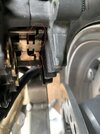
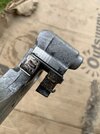
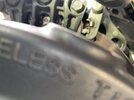
They should look like this when you are done. I extended my pistons before returning them to this position after cleaning. When returning pads to the caliper, ensure that the right pad is set inside the two pins that are circled on the spring clip. As well the clip at the back of the caliper must be cleaned and the pads must straddle the center bar of the clip in order for the pads to move freely with the caliper. Last pic was meant to show the straddle. Thought I had a better one.




Last edited:
I am, and we, are not sure that my original SMC was causing any rear brake issues. The brakes seem to perform the same before and after the change. Without a specialized camera on a bendy cable (like a bore-scope) I don't know how to take a photo of the front of the rear right caliper while it is on the bike.What you’re describing is not a warped rotor, but a misaligned rear caliper, probably due to a few different things.
You said you cleaned the rear caliper/pistons?
Did you remove the caliper off the rotor, remove the spring clip and clean underneath it?
Did you move/remove the pistons to clean the area where they go through the seals? If you did not do this, this may be the reason the pistons are not moving as they should.
Was the rear caliper replaced correctly?
Was the guide dowel(s) cleaned and very lightly greased with rubber friendly grease?
Is the small white O-ring on the pad retaining pin?
Is the rear grommet torn, displaced, or jammed up?
Take a picture of the RIGHT REAR pads as they sit in the front retaining clip.
Your rear caliper mounting bracket may be damaged, as they are often found when the SMC goes out, it takes this bracket with it.
Here's some pictures of the brake pads. This may tell you and some others a story. I don't see any gap between the pads and the rotor.
I cleaned the pistons, the hangar pin, the sliders, and the facing side of the pad spring. But I did not remove the pad spring and clean its upper side. If the pad spring fails, can that prevent the pads from receding fully...? What type of failure is idiosyncratic on the st1300...?
Attachments
I cleaned the face a bit, but the eraser didn't do much. I used my tricks for cleaning guitar contacts... Fine sandpaper to clean the "dot" and contact cleaner with super fine flexible abrasive for the "dial" face. It's a real beeotch to remove and replace. I hope the highest 2 bars aren't now affected.The calipers have machined grooves in them where the seals sit. To clean these means you have to detail strip the caliper (take them apart) and clean the groove with a soft piece of wood or plastic.
You would also need to completely re-bleed the entire system again.
Think of it like a saddle on your guitar bridge, you remove the saddle, clean the slot, then replace the saddle, then re-tune it.
This is quite a job to take on, and perhaps you may want to just use the levers to extend the pistons a bit, and clean off the dirt ring where it sits in the seal rather than taking it all apart.
Use a toothbrush and brake fluid to clean them up, do NOT use any brake spray or you will risk damaging the rubber bits.
Congratulations on your fuel sender unit.
How did you correct it? Cleaning the face or the pressure sending unit?
I pushed out the pistons somewhat with a block of wood to avoid pushing them out all the way and cleaned with super fine flexible abrasive.
Last edited:
Share:


